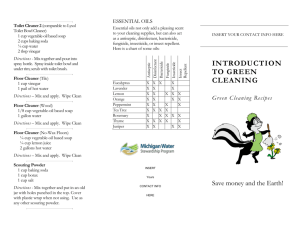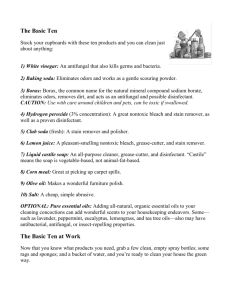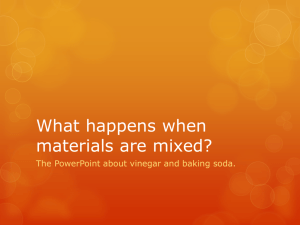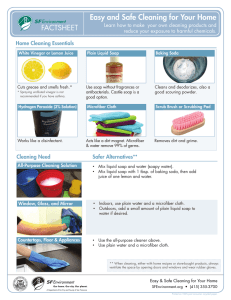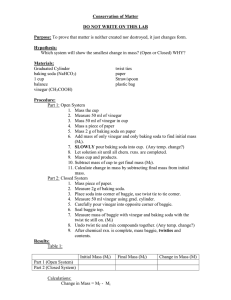`Green` Cleaning - Yolo-Solano Air Quality Management District
advertisement
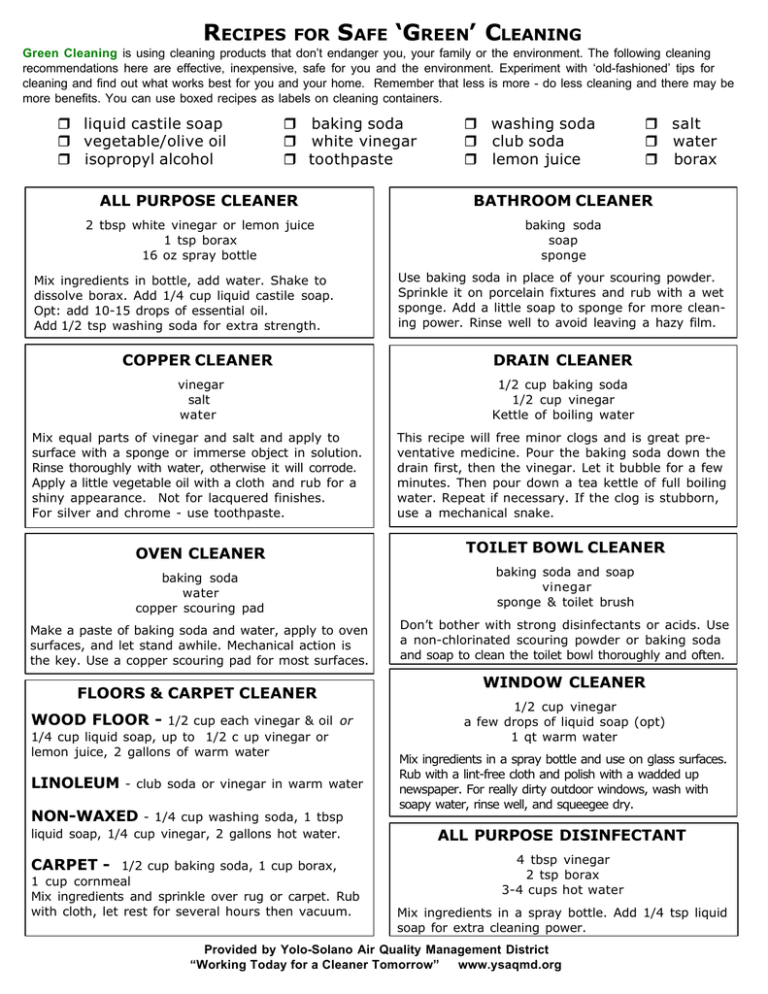
RECIPES FOR SAFE ‘GREEN’ CLEANING Green Cleaning is using cleaning products that don’t endanger you, your family or the environment. The following cleaning recommendations here are effective, inexpensive, safe for you and the environment. Experiment with ‘old-fashioned’ tips for cleaning and find out what works best for you and your home. Remember that less is more - do less cleaning and there may be more benefits. You can use boxed recipes as labels on cleaning containers. r liquid castile soap r vegetable/olive oil r isopropyl alcohol r baking soda r white vinegar r toothpaste r washing soda r club soda r lemon juice r salt r water r borax ALL PURPOSE CLEANER BATHROOM CLEANER 2 tbsp white vinegar or lemon juice 1 tsp borax 16 oz spray bottle baking soda soap sponge Mix ingredients in bottle, add water. Shake to dissolve borax. Add 1/4 cup liquid castile soap. Opt: add 10-15 drops of essential oil. Add 1/2 tsp washing soda for extra strength. Use baking soda in place of your scouring powder. Sprinkle it on porcelain fixtures and rub with a wet sponge. Add a little soap to sponge for more cleaning power. Rinse well to avoid leaving a hazy film. COPPER CLEANER DRAIN CLEANER vinegar salt water 1/2 cup baking soda 1/2 cup vinegar Kettle of boiling water Mix equal parts of vinegar and salt and apply to surface with a sponge or immerse object in solution. Rinse thoroughly with water, otherwise it will corrode. Apply a little vegetable oil with a cloth and rub for a shiny appearance. Not for lacquered finishes. For silver and chrome - use toothpaste. This recipe will free minor clogs and is great preventative medicine. Pour the baking soda down the drain first, then the vinegar. Let it bubble for a few minutes. Then pour down a tea kettle of full boiling water. Repeat if necessary. If the clog is stubborn, use a mechanical snake. OVEN CLEANER TOILET BOWL CLEANER baking soda water copper scouring pad baking soda and soap vinegar sponge & toilet brush Make a paste of baking soda and water, apply to oven surfaces, and let stand awhile. Mechanical action is the key. Use a copper scouring pad for most surfaces. Don’t bother with strong disinfectants or acids. Use a non-chlorinated scouring powder or baking soda and soap to clean the toilet bowl thoroughly and often. FLOORS & CARPET CLEANER WOOD FLOOR - 1/2 cup each vinegar & oil or 1/4 cup liquid soap, up to 1/2 c up vinegar or lemon juice, 2 gallons of warm water LINOLEUM - club soda or vinegar in warm water NON-WAXED - 1/4 cup washing soda, 1 tbsp WINDOW CLEANER 1/2 cup vinegar a few drops of liquid soap (opt) 1 qt warm water Mix ingredients in a spray bottle and use on glass surfaces. Rub with a lint-free cloth and polish with a wadded up newspaper. For really dirty outdoor windows, wash with soapy water, rinse well, and squeegee dry. liquid soap, 1/4 cup vinegar, 2 gallons hot water. ALL PURPOSE DISINFECTANT CARPET - 1/2 cup baking soda, 1 cup borax, 4 tbsp vinegar 2 tsp borax 3-4 cups hot water 1 cup cornmeal Mix ingredients and sprinkle over rug or carpet. Rub with cloth, let rest for several hours then vacuum. Mix ingredients in a spray bottle. Add 1/4 tsp liquid soap for extra cleaning power. Provided by Yolo-Solano Air Quality Management District “Working Today for a Cleaner Tomorrow” www.ysaqmd.org GREEN CLEANING Eco-friendly products can be found in supermarkets or natural-food, hardware, and home-improvement stores. They can be effective, inexpensive, safe for you and the environment. Choose dish and laundry detergents and all-purpose cleaners that are plant-based (corn, palm kernel, or coconut oil). Most conventional dish and laundry detergents are made from petroleum, a nonrenewable resource. Phosphates, which choke waterways, can be found in dishwasher detergents. Safety Tips: Mix ingredients in a well-ventilated area Label containers and store in a safe place Baking soda - this mild alkali powder can be used for a variety of household cleaning purposes, such as removing stains from tile, glass, oven doors, and china; cleaning the inside of refrigerators; helping to absorb odors; and removing baked on food from pans. It also acts as a strain remover for fruit juices and other mild acids. Use containers with tight fitted lids Don’t reuse old containers from other cleaners Don’t mix bleach and ammonia or quaternium compounds they create highly toxic chlorine gas. Don’t store in food containers Test an area before using any cleaner Borax - A powder or crystalline salt sold in most grocery stores, borax is a water softener and disinfectant. It makes an excellent freshener when added to laundry and is an allround deodorizer. Castile soap - A mild soap available in liquid or bar form that can be used for general-purpose cleaning. It was once made from olive oil, but now may include other vegetable oils as well. Club soda - A stain remover and polisher. Avoid chlorine bleaches and detergents containing phosphates as these are known to harm the environment. Avoid aerosol sprays as they disperse ingredients through the air and make them easy to inhale. Even non-toxic ingredients can irritate eyes, noses, and lungs. Carelessly shaken powders can also spread through the air and cause irritation. Cleaning Tips: Dusting - Re-use dryer sheets for dusting Laundry - Run washing machines at full load; wash small amounts of clothes by hand or use the half load or economy settings. Wash clothes at lower temperatures. Dry clothes outside when the weather permits, or on a rack, instead of using the tumble dryer. Use a broom, dustpan and brush instead of a vacuum cleaner when appropriate. Buy reusable dustbags for your vacuum cleaner if available. Run dishwashers at full load or wash small amounts by hand. White vinegar helps kill bacteria, mold, and viruses. To kill food-borne pathogens such as salmonella or E coli use hot, soapy water to wash all cutting boards, dishes, knives, and surfaces that have touched raw meat or eggs. All information is general in nature and is not intended to be used as a substitute for appropriate professional advice. Corn Meal - Used for carpet spills. Cream of tartar - This common baking ingredient is a mild acid that can be used as a sink and bathtub stain remover. It can also be used to remove spots from aluminum cookware. Hydrogen peroxide - A mild alternative to chlorine bleach that can be used for stain removal and mild bleaching and sterilizing. Lemon juice - This familiar ingredient can be used to lighten stains and cut grease. It can also be used to remove tarnish can be used on brass, copper, bronze, and aluminum (not to be used on silver). Lemon oil - Use as a furniture polish. Olive oil - Use as a furniture polish. Pure essential oils - Add all-natural organic essential oils to your cleaning concoctions for a pleasing scent. Lavender, peppermint, eucalyptus, lemongrass, and tea tree oils may also have antibacterial, antifungal or insect-repelling properties. Washing soda - A stronger alternative to baking soda, washing soda can be used as a water softener in conjunction with laundry detergents (gloves are recommended as it may irritate skin; not to be used with silks, woolens or vinyl). White vinegar - Good for a variety of household cleaning task, vinegar may be used to help kill germs and deodorize, remove some carpet stains, and clean coffeemakers, chrome, cookware, and countertops. It can also be used to unclog drains. Note that while white vinegar has a slight scent while wet, when dry, it leaves no odor. However, don’t use in on acetate fabrics because it can dissolve the fibers.
